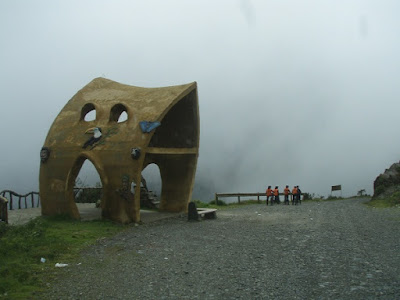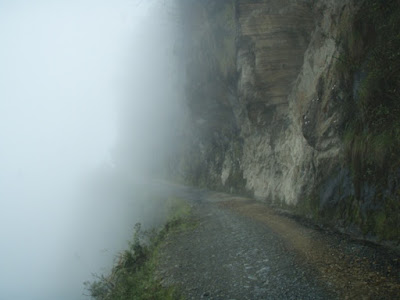How to describe the Yungas Road. Well, I suppose we should tell you a little bit more about it first. This very famous road was built in the late 1930s by slave labor following the Chaco War, fought between Bolivia and Paraguay. Since its inception it has taken countless lives. It has been estimated that between 200 and 300 souls have been lost on the road yearly. Because of the staggering amount of fatalities, a new road has been built to bypass the old existing road which is now mainly used for bike tours and adventurous cab drivers ferrying locals between La Paz and Coroico.
Our morning began around 6:30 at the Madness shop, a few blocks from our hotel. Our guide, Hector, told us we were required to wear a goofy orange vest and a full face helmet all throughout the ride. Gortex pants, elbow or knee protection and gloves were optional. We met our fellow riders, Karen from France, and Rebecca, a fellow American from Chicago. Afterwards we hopped into the support vehicle with our mountain bikes secured on the roof and made our way through La Paz to the beginning of our ride.
Our driver took us a 1000 meters in elevation to the starting point, La Cumbre at 4,640 meters. There we suited up in our gear. I opted only for knee pads, while June decided to ride fully geared. It was a bit chilly, being around 40 degrees Fahrenheit. Our bikes were checked, and we were sized up for each of them before Hector explained the safety rules and basics of the first part of our ride. We were able to ride around the lot and get adjusted to our bikes. June and I recognized a statue on a nearby hill as being one shown on the History Channel show Ice Road Truckers, in the second season, which took place on the Death Road.
When everyone was situated, we began the first portion of our tour on a paved road, gliding down the hill at speeds up to 55kph (34+ mph), stopping every 500 hundred meters or so. At these stops, Hector would ensure our comfort and tell us what to expect on the next leg of the journey down to the entrance of the Yungas Road, such as potential animals that may stray into the road and upcoming traffic that we may encounter. The ride was smooth and exhilarating, as we have never reached such speeds on a bike. There were large, jagged peaks surrounding us; the rocks on these peaks being black in color, with short, yellow tinted grass due to the high altitude.
Within the paved section of our ride, we dropped 2,050 meters. Our driver followed along, and then transported us 8km uphill to the entrance of the old Youngas Road. There, we felt a difference in the temperature, as we would throughout the journey while traveling into lower altitudes. Hector had June switch bikes, although we were not sure why. We set off down hill along the uneven terrain that consisted mostly of large, loose rocks. Having little experience riding such terrain downhill on a mountain bike, June's first reaction was "holy cow, is this outside my ability?!" I also felt a little unnerved by the terrain and speeds, but it was really out of our control.
At our first checkpoint, June expressed some concerns she had with her inexperience on such terrain with a mountain bike. Hector gave us many suggestions to improve our ride, including how to increase and decrease our speed, how to take on corners, and proper placement of our arms to release the pressure off of our wrists. This helped to assuage some of our apprehension and the ride was easier from that point on.
We are very glad we chose to go with a reputable company. We couldn't have asked for a better guide than Hector, with his ten years of experience on the Yungas, and his personal knowledge of mountain biking. He was informative, patient, and spoke great English, which made the experience all the better.
Riding the Death Road was definitely one of the most memorable days we have had thus far on our journey, and was well worth our money. If we had the option, and finances to do it all over again, we would in a heart beat. It was one of the biggest thrills we have had yet.
Gavin y June
more videos and photos after the cut:
*not all these photos are mine, some were taken by the driver of our support vehicle, as were all the videos, enjoy!*



























4 comments:
These photos and videos are AMAZING!!!! The "murder alley" and the ambiguity of the fog looks incredibly scary! I can't believe how close you all are standing to the cliffside. This photo looks like something you'd see in a cyclist magazine! Maybe you should submit it....it'd probably be displayed! I also very much love the cross statue photo. This photo gives the deaths more meaning. While reading the post, in my mind I just thought of small wood crosses, like what you see on the side of highways up here to remember accidents. But, these statues, with the waterfalls amongst them, seem to have more significance.
I'm happy that your bikes were true mountain bikes. I think I would've been doubting my abilities too, and definitely would've worn the full gear as well. I don't even know if I could've allowed myself to go that fast!
As Wikipedia explains it: 'The origin of roadside crosses in the United States has its roots with the early Hispanic settlers of the Southwestern United States, and are common in areas with large Hispanic populations. Formerly, in funerary processions where a group would proceed from a church to a graveyard carrying a coffin, the bearers would take a rest, or "descanso" in Spanish, and wherever they set the coffin down, a cross would be placed there in memory of the event. The modern practice of roadside shrines commemorate the last place a person was alive before receiving fatal injuries in a car crash, even if he should actually die in a hospital after the crash.'
Mark Twain's Wisdom on Cycling-
U.S. Library of Congress:
"Learn to ride a bicycle. You will not regret it if you live."
I have to admit I am relieved at seeing the quality mountain bikes you guys used. I had an image of something totally different in my mind!
Post a Comment